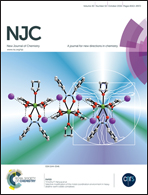Curvature, vacancy size and chirality effects of mono- to octa-vacancies in zigzag single-walled carbon nanotubes
Abstract
Defect curvature KVs (s = 1–8) was developed based on our previously proposed direction curvature theory. As a universal criterion, it could predict reactivities of mono-vacancies (V1) to octa-vacancies (V8) in the (n,0) tube. Calculated results showed that vacancy formation energies Ef decreased with increasing KVs and vacancy modes with removed carbon atoms along the armchair chain of the carbon tubes were more (for V2 and V3) or the most stable (for V4–V8) in each kind of Vs, because their corresponding KVs values were larger or the largest. Local product structures were inclined to have small rings including pentagon, heptagon, octagon and nonagon. Vacancy formation energies Ef obviously increased upon increasing the n value of (n,0) tubes as the vacancy size s ≤ 3 and s = 5, and for the other larger s there was a little increase for Ef as n, and they were minimal as n was 6 and 9, owing to the same oscillation rule of the energy gaps. An odd–even oscillation rule for the smallest Ef among each kind of Vs as the vacancy size s existed. For two dissociation processes, namely Vs → Vs−1 + V1 and 2Vs → Vs−1 + Vs+1, the calculated results for two corresponding dissociation energies confirmed that the vacancies Vs were more stable when s was even.


 Please wait while we load your content...
Please wait while we load your content...